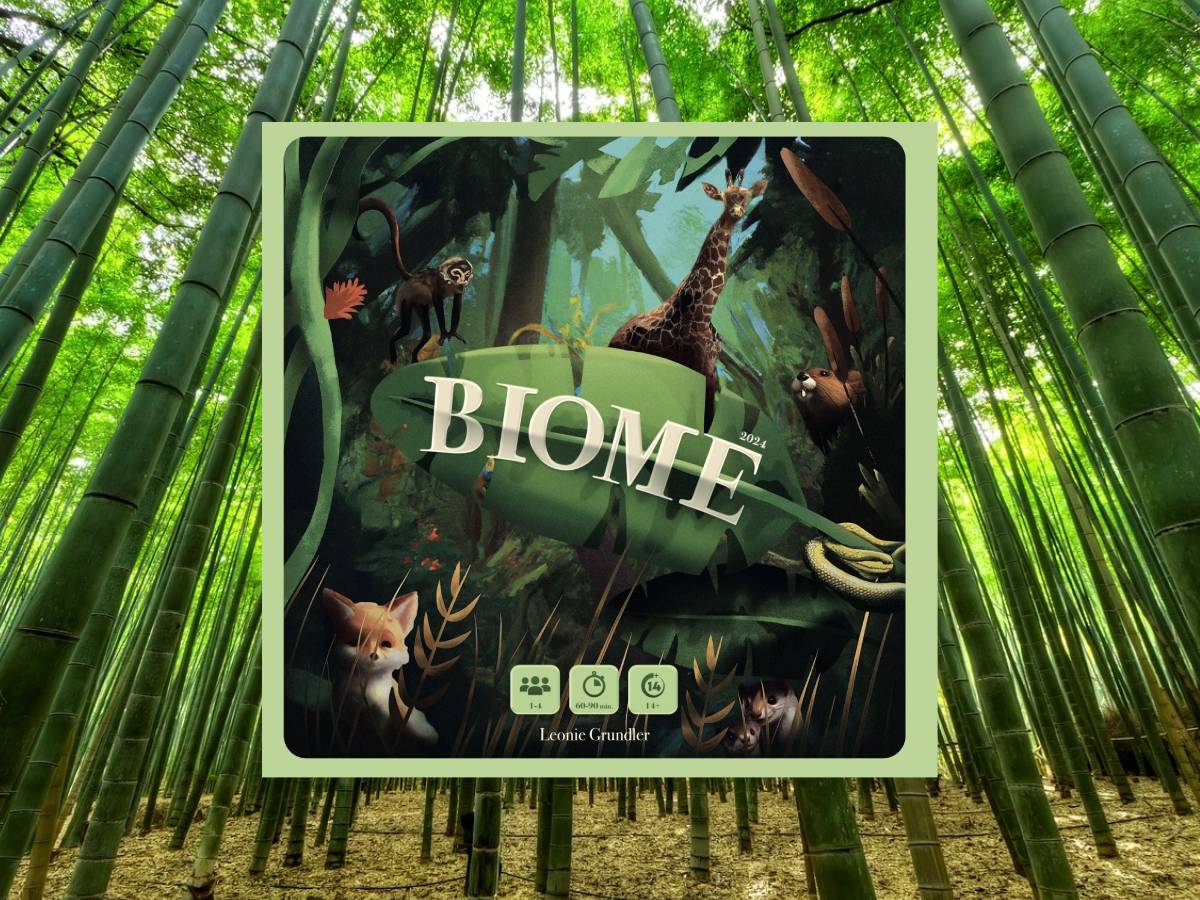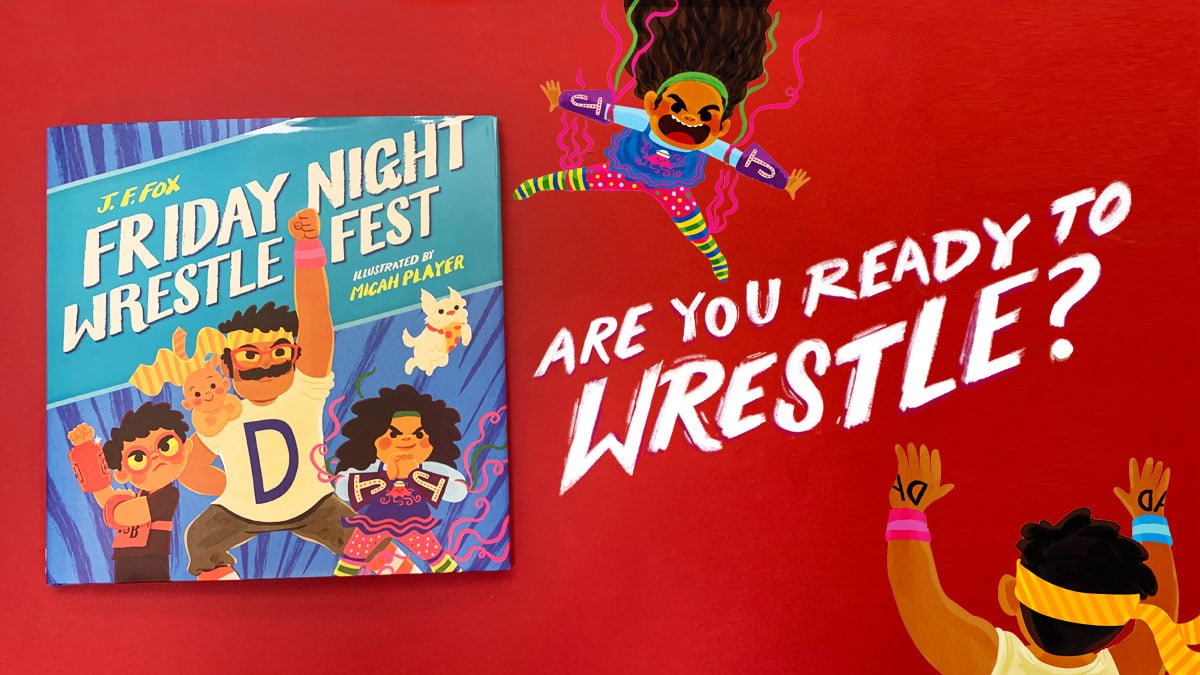Biome /ˈbīˌōm/ (noun): a large, naturally occurring community of flora and fauna occupying a major habitat, e.g., forest or tundra.
Play as a fearless environmentalist, working to develop a flourishing and diverse biome!
What Is Biome?
Biome is a tableau-building game for 1-4 players, ages 14 and up, and takes about 90 minutes to play. It’s currently seeking funding on Kickstarter, with a pledge level of $54 for a standard copy of the game, or $69 for the deluxe version. There is also a limited Earlybird pledge for the standard edition, which is $49. The deluxe edition has all of the components of the standard edition, with the addition of a removable pulp organizer trays with lids for resource storage, screen printing on the baby animals, the Bountiful Biome mini Expansion, and spot UV on the box.
Biome was designed by Leonie Grundler and published by Lioness Games, with illustrations by Jessica Apel and Grzegorz Siwek. It should also be noted that Dall-E, an AI art generator, was used in development of Biome’s artwork, and some of the artwork in the production version of the game will be AI-generated.
New to Kickstarter? Check out our crowdfunding primer.
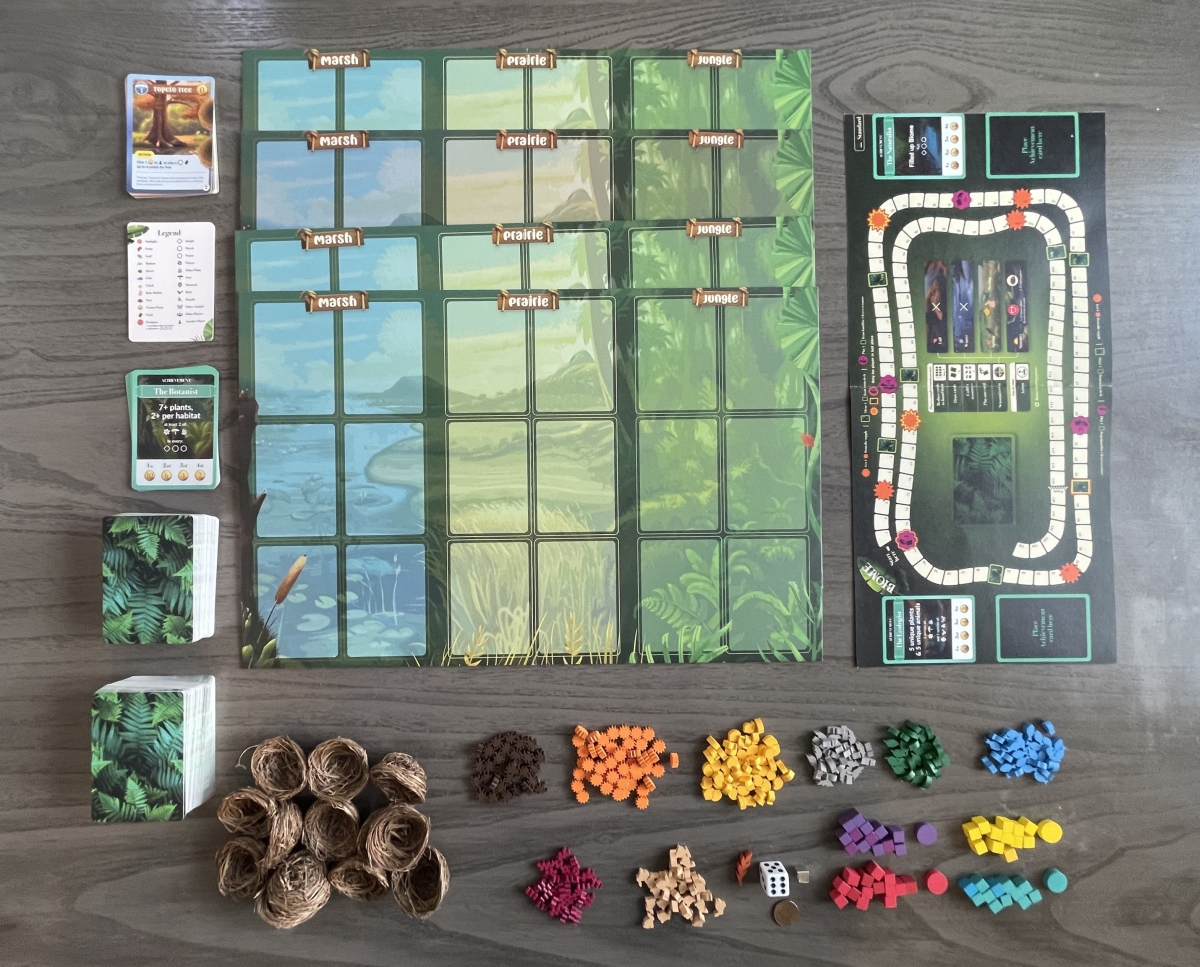
Biome Components
Note: My review is based on a prototype copy, so it is subject to change and may not reflect final component quality.
Here is what comes with the standard game:
- Double-sided centerpiece board
- 4 player mats
- 64 wooden cubes, 16 each in 4 player colors
- 12 starting cards
- 8 achievement cards
- 2 white wooden cubes
- 185 wooden sun, insect, fruit, leaf, fish, and rodent tokens
- 50 wooden chicks
- 30 wooden rabbits
- 16 straw nests
- 1 metal coin
- 4 legend cards
- 1 standard die
- 1 starting player token
- 4 player point tokens
- 1 season tracker token
- 170 plant and animal wildlife cards
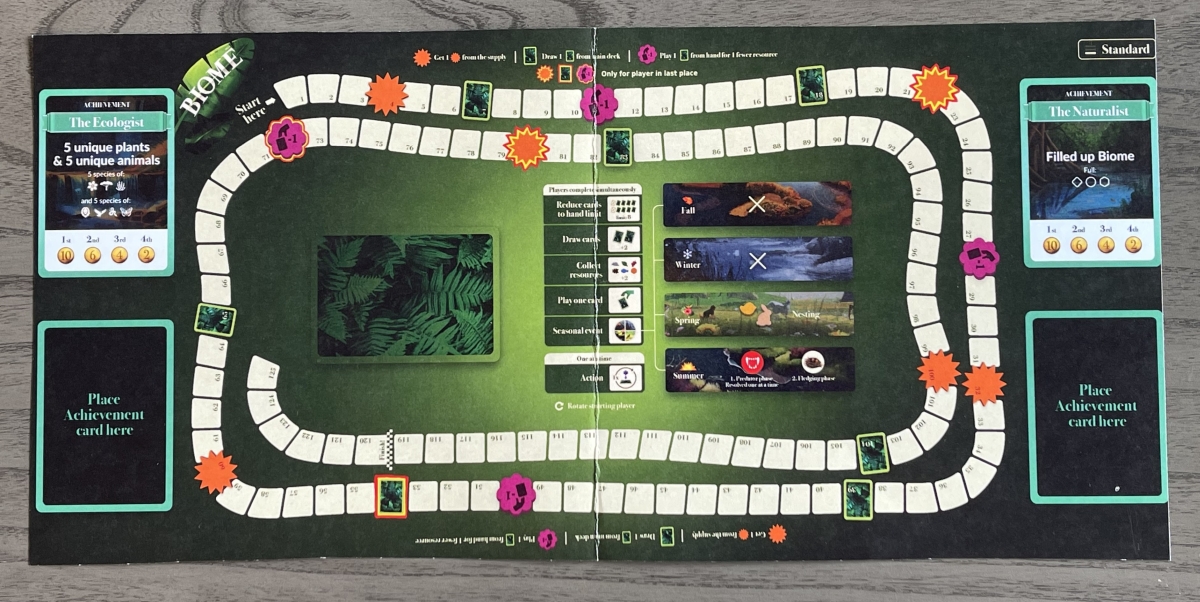
The Centerpiece Board is where you will keep track of each player’s scores, and the progression of the seasons and years. There are also spaces on the board for the achievement cards, and the deck of plant and wildlife cards. There are various milestones along the scoring track, where players receive rewards when they reach or pass those locations.
This board was printed on heavy paper when I received my prototype; it’s my assumption that the final version of the board will be cardboard, like you get with most other board games. I would love to see a larger board as well—while it is certainly playable, there’s a fair amount of information printed on the board which can be difficult to read from across the table.
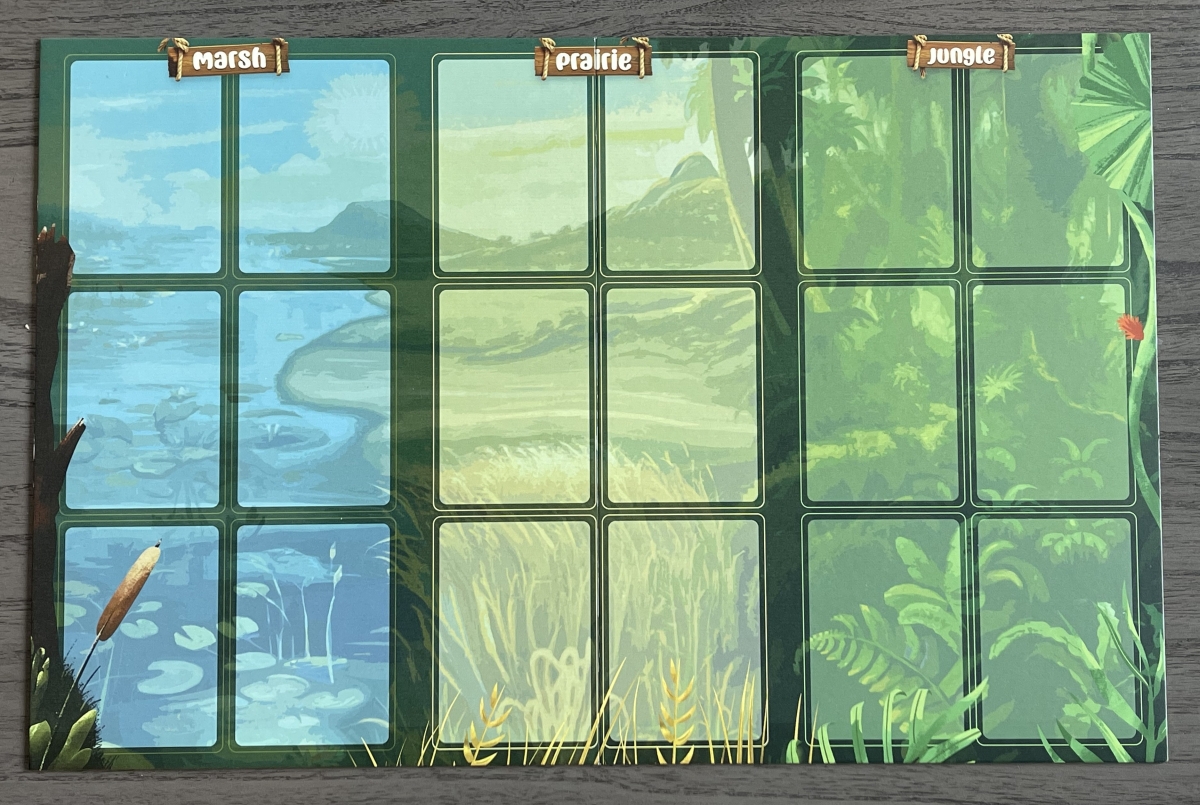
The Player Mats have spaces for as many as 18 cards, spread out over 3 different habitats. It is also printed on thick card, which is likely to remain the same for the final production version of the game.
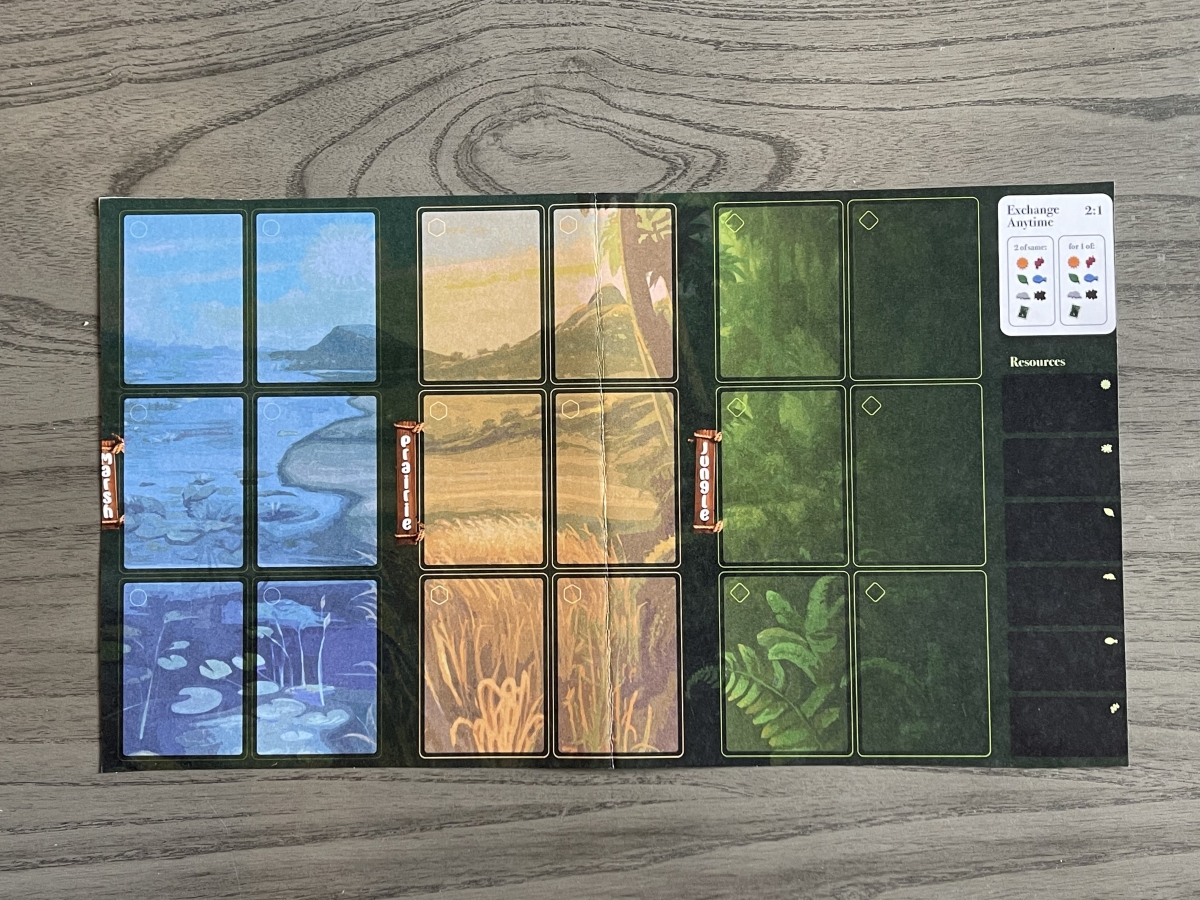
My prototype also included an alternate version of the player mats. These mats are likely to be closer to the final ones in design, as they include spaces to store resources, as well as a graphic reminder of the rule that you can, at any time, exchange any two resources for one of another.
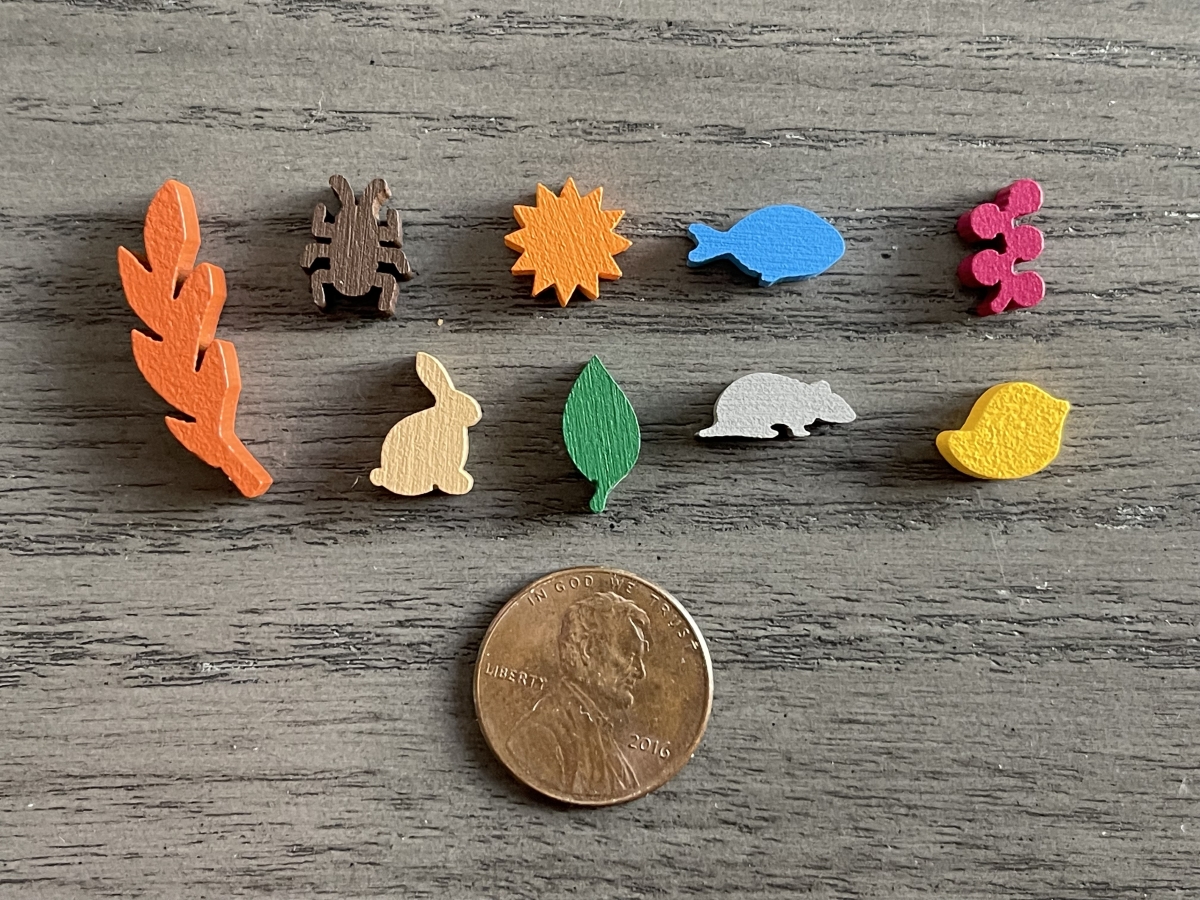
There are many different wooden tokens in Biome, most of which are used for the various resources in the game. As you can see from the above photo, the tokens are also quite tiny.

One of the more unique components of Biome are the 16 straw nests. These nests are used during the Baby Animal phase in the Spring season, when birds or rabbits will produce babies.
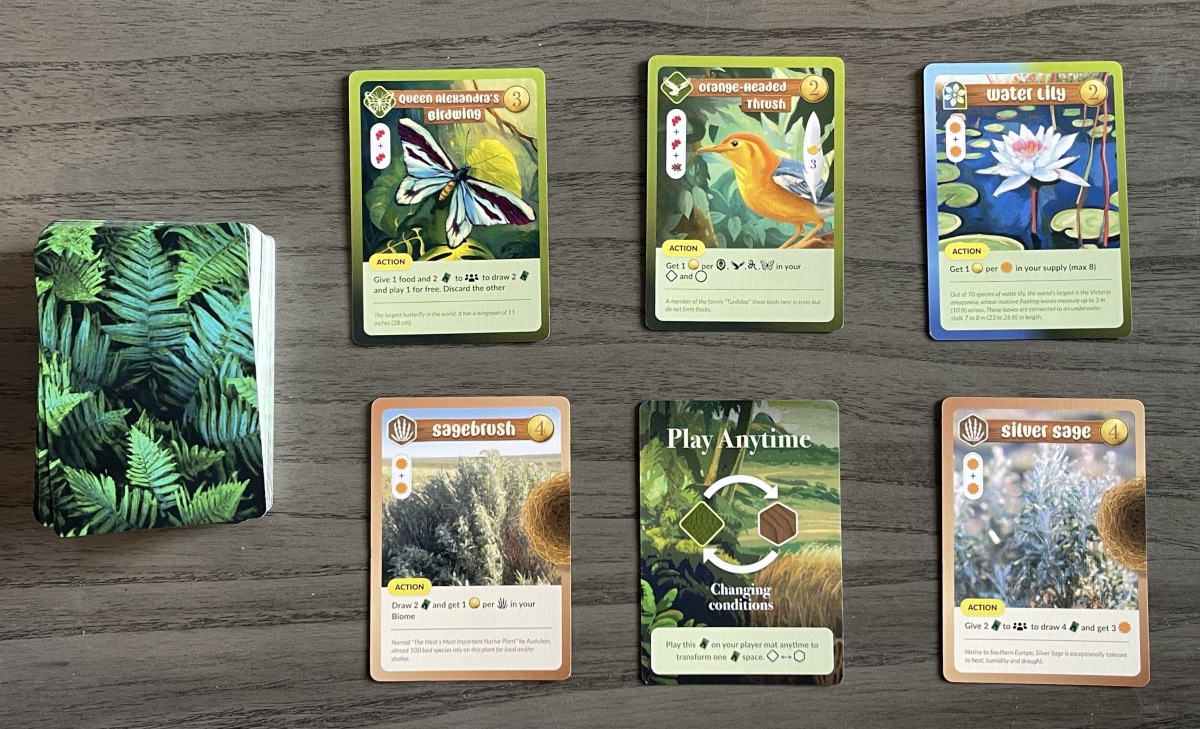
During the course of the game, you will be drawing from a large deck of plant and animal wildlife cards, and playing those cards into your tableau. The color of the cards indicates which habitat you can play them into: marsh, prairie, or jungle. Within the deck are also a number of “Changing Conditions” cards, which will allow you to convert a space from one of the habitat types to another.
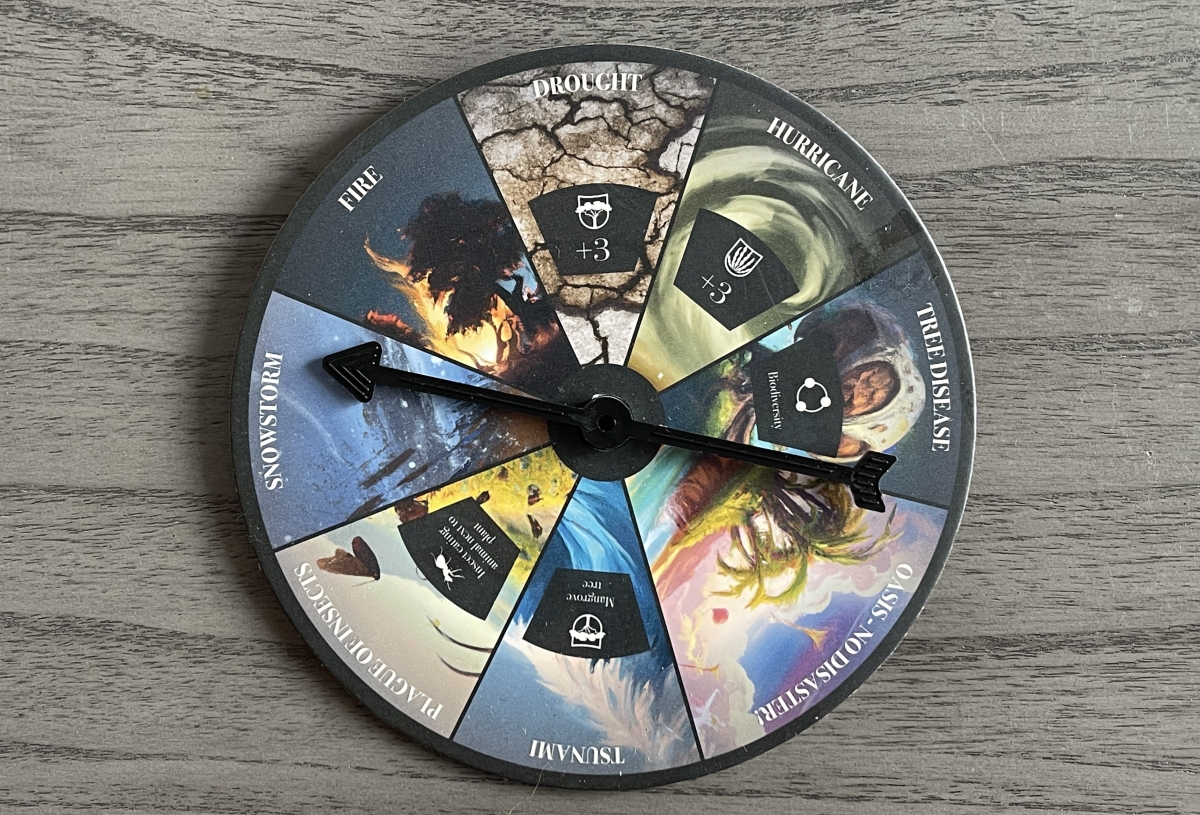
Both the standard and deluxe pledges of the game include the Disasters mini expansion. Beginning in the Summer of the 1st year of play, disasters will randomly occur. These might include destruction of plants or animals, discarding of cards or other resources, or elimination of nests. Some of the disasters are preventable if a player has met certain prerequisites in their biome.
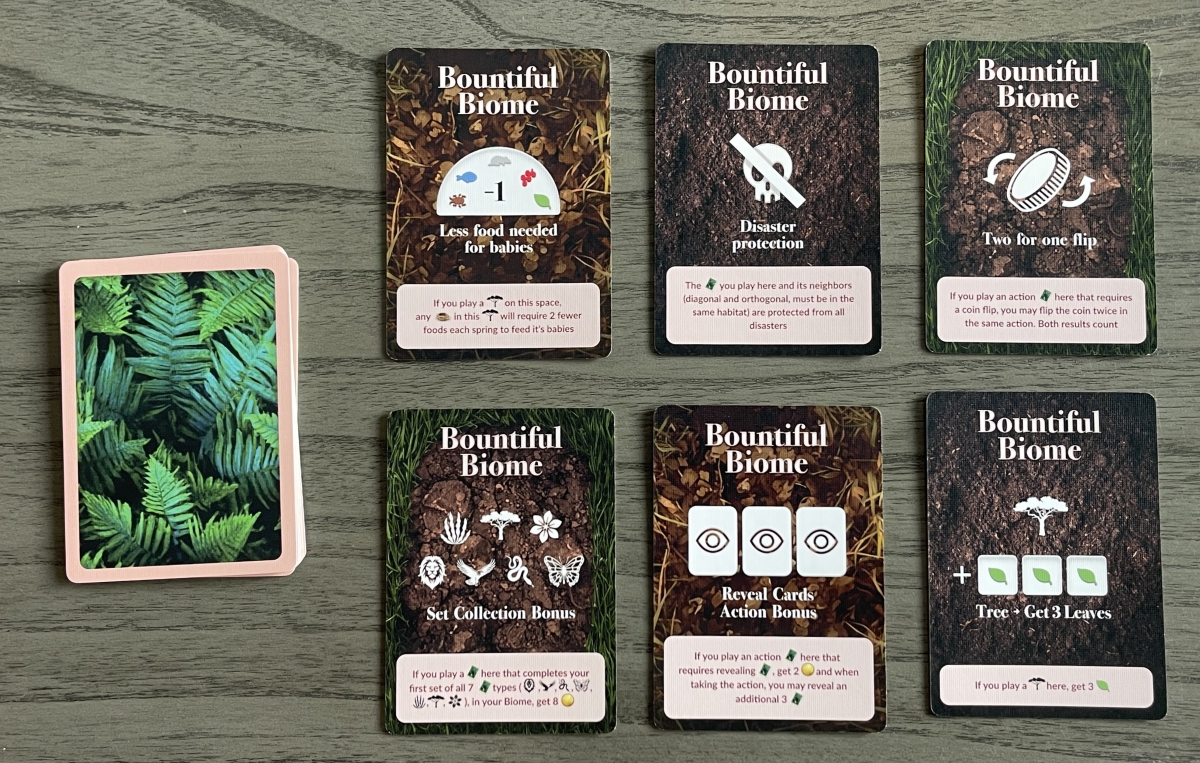
Included in the deluxe pledge is also the Bountiful Biome mini expansion. These cards enhance the abilities of future cards played on top of them.
How to Play Biome
The Goal
The goal of the game is to earn points by playing wildlife cards, winning achievements, taking actions, raising baby animals, and predating your opponents’ baby animals.
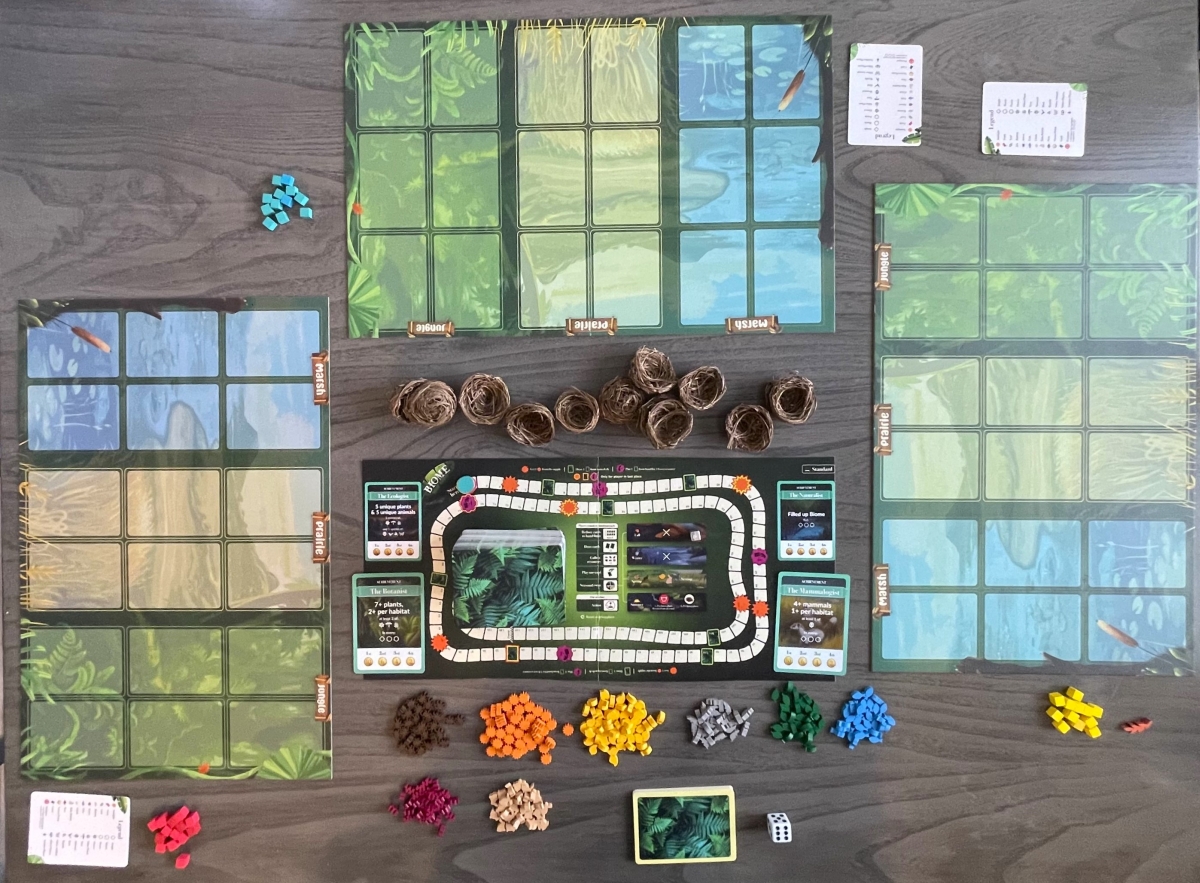
Setup
Each player places a player mat in front of them. Then, place the centerpiece board in the middle of the table, with the “standard” side showing.
Shuffle the 8 “Changing Conditions” cards into the 170 plant and animal wildlife cards to form the main deck. Place the deck, nests, and wooden tokens next to the board.
Each player chooses a color and takes the corresponding cubes and player point tracker. The player point tracker goes on the “start here” space of the centerpiece board.
Shuffle the achievement cards and randomly pick two for the game, placing them onto the centerpiece board.
The starting player is whoever has the most houseplants. They receive the starting player token.
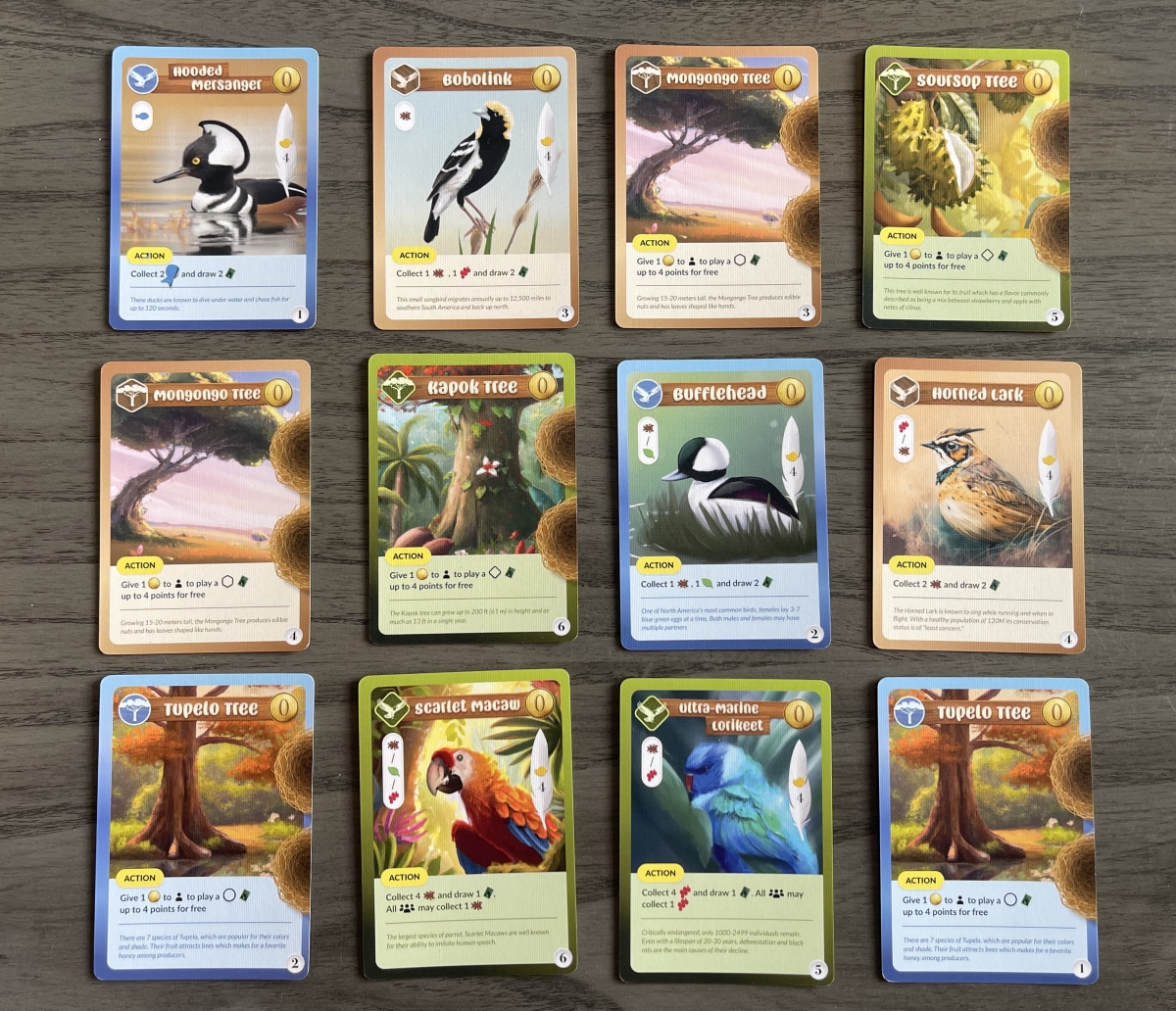
Beginning with the starting player, each player rolls the die and takes the bird and tree cards corresponding to their roll, placing them orthogonally next to each other in the matching habitat on their player boards.
Each player is then dealt 3 cards from the main deck, and also given a Legend reference card. They then receive one of each resource, which are placed on the right side of their player mats in the resource storage section.
The phase tracker token is placed on the “Draw 2 cards” space on the centerpiece board, and the season tracker token is placed on the Fall season space of the board. A white cube is placed on the “Year 1” space of the Year track.
Gameplay
The game begins in Fall of Year 1 with simultaneous gameplay phases. Note: at any time during the game, you may discard two of any resource and replace it with one of another resource. This includes cards.
Simultaneous Phase Overview
Every player completes each phase before all players move to the next.
- Hand limit check (skipped at the start of the game). Exchange or discard cards in hand down to a maximum of eight.
- Draw cards. Every player draws 2 cards from the deck.
- Collect resources. Players collect any combination of 2 resources of their choice from insects, leaves, fruit, fish, rodents, and sunlight.
- Play one card. Every player plays 1 card from their hand into their Biome, by paying the associated cost. Players then score the point value, if any, of the card. If the player’s token lands on or passes a point track bonus, they immediately gain that bonus.
Seasonal Event
After the simultaneous phases comes the seasonal event. Fall and Winter events only occur in the advanced game.
Spring
- Baby Animal Phase. All birds placed orthogonally next to nest-bearing plants will make a nest and have chicks. All rabbits orthogonally next to any plant will make a nest and have babies. Take a nest from the supply, place it on the plant between the animals, and place the appropriate number of baby animals in the nest. For birds, it will be the number indicated on the bird’s card. For rabbits, it is always six babies.
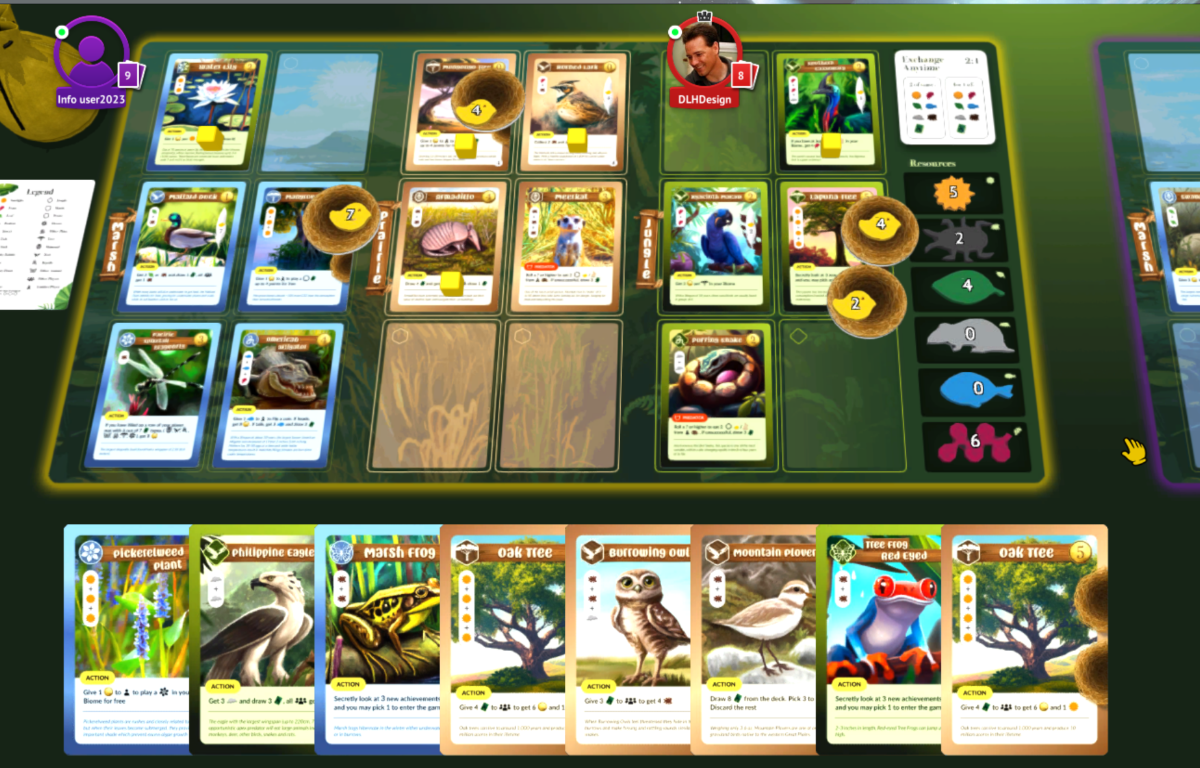
Summer
- Predation Phase. In this phase, if players have any predators in their Biome, they will attempt to eat chicks or baby rabbits in another player’s Biome. One at a time beginning with the player with the fewest points on the track, players with predators choose an opponent’s nest to attack. The nest must be in a habitat that matches the predator’s habitat. Players roll a die, and attempt to get a number higher that the number of plants in the target habitat. If successful, the predator will eat 2 babies, and the attacking player moves up 2 points on the score track per baby. If unsuccessful, the player with the predator draws 3 cards from the deck.
- Fledgling Phase. In this phase, you must feed each baby animal 1 food of a type the mother animal eats. You gain 2 points for each baby fed. After this phase, return all chicks, rabbits, and nests to the supply. Note: there is no penalty for unfed babies, you just don’t score as much.
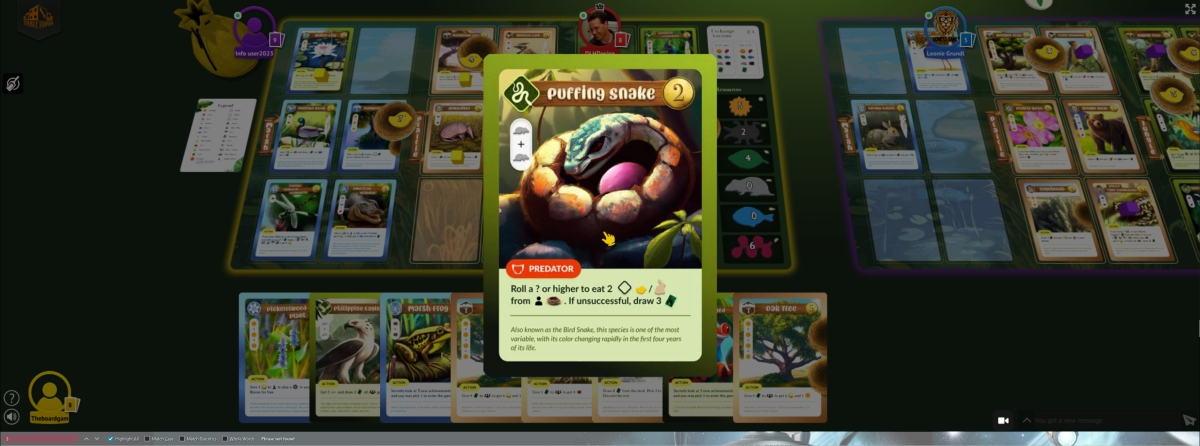
Action Phase
Beginning with the starting player and one at a time, players will choose one of the cards in their Biome and take the action on the card. Any points earned by the action are immediately claimed on the centerpiece board. The card is marked with a player cube to indicate that it has been used, as each card in a Biome may only be used once per game for its action.
Achievements
When a player has achieved the prerequisites for one of the achievements on the centerpiece board, they will place one of their player cubes on the card and earn a number of points dependent on whether they were the 1st, 2nd, 3rd, or 4th person to earn the achievement. Points are scored immediately on the track.
Game End
The game ends when either one player has passed 120 points on the point track, or a player has completely filled up their Biome. At one of those two triggers, one more season is played, and whoever has the most points, wins.
Advanced Play
The advanced game adds two additional seasonal events: Migration and Brumation.
- Migration: players pick one of their animal cards, which will migrate to the Biome of the opponent to the player’s left.
- Brumation: Reptiles “brumate” and their actions may not be activated.
Why You Should Play Biome
I was playing a game of Biome on Tabletop Simulator and the discussion turned to the GeekDad-approved game, Earth. Both Biome and Earth are tableau-building, card-based games that thematically deal with the ecosystem of our planet. But the two games, while having some surface similarities, are inherently quite different.
Earth is, at its heart, an engine-building game. You will be triggering multiple actions on cards you have placed in your tableau, depending on what color is chosen. One of my friends made an excellent observation that in Biome, you’re actually building micro-engines. Each card has an action that may only be used once the entire game. So the timing of when you use a particular action is of paramount importance during the Action Phase.
While some cards’ actions will provide resources, players will still mostly acquire the various resources through both the “Collect Resources” phase, or trading in some resources to gain others. I often found myself in possession of either too many cards, or cards that I didn’t particularly want, so would perform a trade. The balance of this ability works well in Biome, as I always felt challenged to make sure I had the resources I needed, but also never felt stymied by a lack of resources.
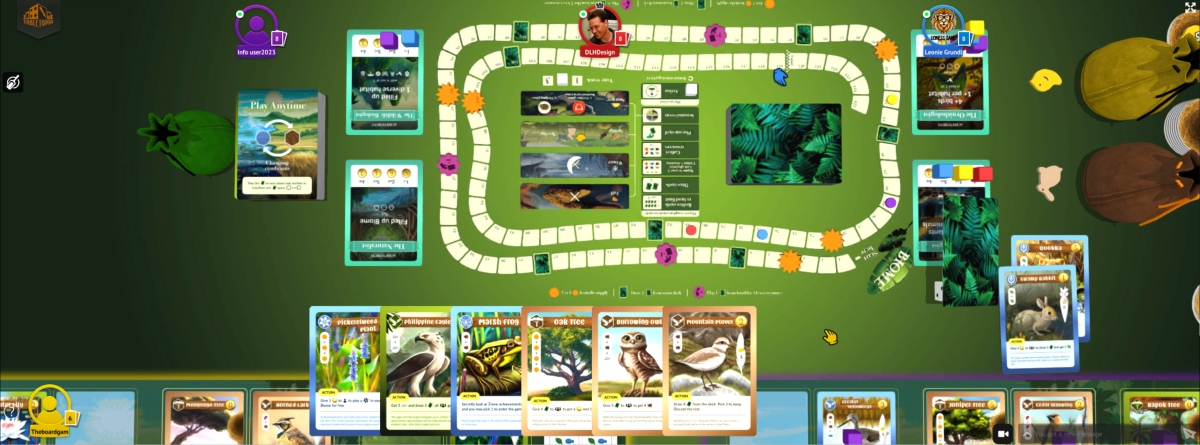
Animals and their interaction with the plants in their habitat is of paramount importance to a game of Biome. Birds can only produce nests in certain plants (trees, generally). If you have a lot of birds or rabbits next to plants, you can potentially then produce a lot of babies in the Spring. During that season, I would usually try to choose either the action of a card that would produce the food I needed to feed the babies, or an action that would allow me to draw several cards, which I could then trade in for the resources I needed to feed them.
Then, in the Summer season, feeding the babies generates a significant number of points, while predating opponent’s nests would deny them points in return. Interestingly, there is no penalty for babies that don’t get fed. I have mixed feelings about this: on the one hand, you don’t end up dwelling on the fact that you’ve doomed baby animals to death. Unfed babies just go back to the supply.
On the other hand, from a gameplay aspect, it seems that there should be some kind of penalty for uncontrolled breeding without the resources to care for them. Perhaps this is an aspect of the rules that will be revisited during the campaign.
Even though a tableau-building game usually feel like a solo game that is being played at the table together, the use of predators during the Summer season provides a nice bit of player interaction. This interaction is increased if you play the advanced game, where you have to migrate animals from your biome to another player’s. Additionally, many actions that one player takes will often provide benefits for the other players.
Overall, I had a good time playing Biome. It is a bright, colorful game that has a fair amount of strategy, but won’t burn your brain while playing, either. Biome also feels well-balanced. Even when someone takes a strong lead, smart gameplay will allow players to close the gap. If you’re looking for a competitive game about our planet whose player interactions are generally more on the gentle side, then you should check out Biome.
For more information or to make a pledge, visit the Biome Kickstarter page!
Click here to see all our tabletop game reviews.
![]() To subscribe to GeekDad’s tabletop gaming coverage, please copy this link and add it to your RSS reader.
To subscribe to GeekDad’s tabletop gaming coverage, please copy this link and add it to your RSS reader.
Disclosure: GeekDad received a copy of this game for review purposes.
